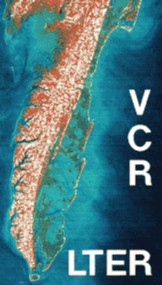 LOW MARSH SUCCESSION ALONG AN OVERWASH MARSH CHRONOSEQUENCE |

John P.Walsh and Joseph C. Zieman
Environmental Sciences
|
 LOW MARSH SUCCESSION ALONG AN OVERWASH MARSH CHRONOSEQUENCE |

John P.Walsh and Joseph C. Zieman
Environmental Sciences
|
The purpose of this study is to describe the process of ecological succession within a Spartina alterniflora dominated low marsh along an overwash marsh choronosequence. Through the use of aerial and satellite photographs, the ages of re-growth marshes following a severe overwash event on Hog Island, Virginia were determined. Sampling plots were established along this chronosequence in marshes of age 1 yr, 6 yr, 13 yr, 21 yr , and in an unburied marsh that is 150+ yr old. Data were collected either within 1m2 permanent sampling quadrats located in each of the three S. alterniflora height zones (short, medium, and tall) inside each plot, or within randomly tossed 0.25m2 quadrats. Significant physico-chemical differences along this age gradient include monotonic decreases in sand grain % in surface sediments and pore water oxidation-reduction potentials, and significant (and monotonic) increases in pore water sulfide and ammonium concentrations. The curves describing end of season production across the chronosequence for both S. alterniflora and the major epifaunal invertebrates were similar in shape, with peak primary and secondary production occurring at the 13 yr old marsh Figure 2. This figure demonstrates that the substrate physico-chemical variables that comprise PC1 (porewater redox and sulfide, surface sediment sand and organic content) are the most reliable predictors of marsh age: the mean factor score curve for this Principal Component shows a monotonic decrease in value with marsh age, with very little variation around each mean factor score. PC2 and PC3 show peak absolute values of mean factor scores for intermediate aged marshes, indicating, that in terms of elevation-production and epifaunal gastropods, a mature marsh is more similar to a young marsh than an intermediate aged one.